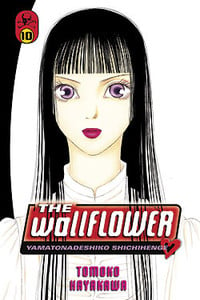Review
by Carl Kimlinger,The Wallflower
GN 10
| Synopsis: |  |
||
Hurt by his mother's repeated rejection and Sunako's inability to deal with his blinding brightness, Kyohei runs away from it all. Naturally this entails eating a lot and occasionally beating the snot out of nearby punks. Sunako, stricken with guilt over her responsibility for his rash course of action, tries—Sunako-style—to make amends. Then it's time for the school sports festival, a harrowing ordeal that pits Sunako against Kyohei on a death-defying obstacle course. And what could possibly be more frightening than Ranmaru flirting with the concept of settling down? How about the sight of Sunako and Kyohei cozying up? Well, maybe cozy is too warm a word. |
|||
| Review: | |||
Is it possible that The Wallflower has hit its second wind? After a mildly engaging ninth volume, the series serves up this tenth offering which, if not the best volume to date, is certainly the best since the first handful. It gets everything that makes the series fun exactly right, while forging new appeal with its slightly meatier storytelling. The humor works well, focusing on character-inspired gags instead of the "them boys sure is hot" jokes of some volumes past. There's an unusual amount of emotional content hidden within the usual hijinks, but the macabre edge to the humor, sharpened by Sunako's slightly off concept of the world, cuts the sentimentality short, preventing a maudlin tone from setting in. Kyohei and Sunako's big reunion scene is every bit as dramatic as one might hope, all while featuring some truly hilarious gags. As always, Sunako displays the fundamental decency and sometimes frightening sense of justice that underlie her dark, twisted exterior, while the boys' personalities have become better defined as the series wears on—helped by Yuki's showing last volume and all of the adorable Takenaga-Noi fluff from the past. The camaraderie between them and Sunako feels more real than before, especially when tested by Kyohei's departure. For his part, Kyohei's trauma, the preposterousness of its source aside, lends him a vulnerability—particularly regarding his relationship, such as it is, with Sunako—that is most becoming. He finally feels like a real, live character rather than a pretty face with a bad attitude. The chapters focusing on him and Sunako that bookend this volume are unexpectedly touching, and the scenes of them walking together through the shopping district rank among the series' best (barring the bit with the Waffen SS uniform and chainsaw in volume one). The sports festival story is pure filler of course, amusing byplay between Sunako and Kyohei notwithstanding, and there is a definite shortage of space given over to the supporting cast, although Ranmaru does get some long-neglected growth. The introduction of a potentially serious romantic interest goes a long way towards improving his likeability, and adds some much-needed complexity to his character. After generally trashing Tomoko Hayakawa for a shiftless layabout of an artist, the (perhaps unintentional) utility of her bipolar art style has finally begun to register. The simplified form that characters often take keep the humor rolling with super-deformed ease while providing a stark contrast that makes the carefully rendered moments that accentuate important scenes stand out even more than they would have otherwise. The contrast between the two is also sometimes parlayed into knowing little jokes. Hayakawa's bishounen are as hormone-laden as ever and, strangely enough, begin to grow on you even if they were initially off-putting. Sunako is stunning. Period. Frightening, silly, beautiful, and overpoweringly cool. And as a plus, the greater focus on her this volume means she spends a large portion of her time in non-SD forms. Hayakawa rarely draws backgrounds, which compounds her problem with rocky transitions in time and space. Del Rey generally puts together pretty solid releases. This is a good-looking volume overall, and features plenty of the author's usual ramblings on various bands, as well as her love for her cat. There're also some translation notes, most of them dealing with cultural references, and an untranslated next-volume preview. After weathering an interminable stretch of intermittently entertaining filler, volume ten simply ladles on the Wallflower gravy. Kyohei grows as a character, Sunako shines (both literally and figuratively), their sort-of, de facto relationship starts to form something interesting, and even Ranmaru is finally fleshing out. Given the uneven quality of the series, it probably wouldn't do to get one's hopes up, but this is Wallflower at its very best. |
|
The views and opinions expressed in this article are solely those of the author(s) and do not necessarily represent the views of Anime News Network, its employees, owners, or sponsors.
|
| Grade: | |||
Overall : B
Story : B-
Art : B
+ Kyohei is even more sympathetic than usual; interesting evolution in the Kyohei/Sunako relationship |
|||
| discuss this in the forum (1 post) | | |||
| Production Info: | ||
|
Full encyclopedia details about Release information about |
||